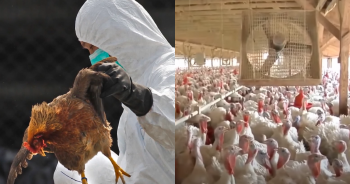A human case of avian influenza, commonly known as bird flu, has been detected in Texas, following exposure to dairy cattle believed to be carriers of the virus. This announcement follows recent reports from federal agencies indicating the presence of the virus in dairy herds across multiple states, including Texas.
The Texas Department of State Health Services reported that the affected individual exhibited only one symptom, inflammation of the eye. The unnamed patient underwent testing at the end of last week, with the Centers for Disease Control and Prevention confirming the diagnosis over the subsequent weekend. The patient is currently receiving treatment with oseltamivir, an antiviral medication effective against various influenza strains, including influenza A, B, and swine flu.
Image/Story Source Credit: KENS 5 News via YouTube Video
Dr. Céline Gounder, a medical contributor for CBS News and public health editor-at-large at KFF Health News, highlighted the mild nature of this case on “CBS Mornings” Tuesday, noting that the infection was limited to conjunctivitis, also known as pink eye. This is significant because the infection is not in the respiratory system, reducing the likelihood of transmission between humans.
Officials in Texas have noted that human cases of H5N1, the strain of bird flu in question, can range from mild symptoms like eye infections and respiratory issues to more severe outcomes such as pneumonia and death.
According to the CDC, this marks only the second instance of human bird flu infection in the U.S. The virus predominantly affects wild birds but can spread to domestic species. The current outbreak has resulted in the deaths of millions of birds worldwide and has also affected other mammal populations, including sea lions, seals, and a polar bear.
Dairy cattle are the latest animal group to contract a strain of the virus, with confirmed cases in Texas, Kansas, and Michigan. This is the first time dairy cattle in the U.S. have been affected by this specific infection.
Image/Story Source Credit: KENS 5 News via YouTube Video
Despite the transmission to a human, the Texas health department maintains that the spread of bird flu from person to person remains “extremely rare.” The virus has not mutated in a way that increases its transmissibility among humans. The department is advising affected dairies on protective measures for workers and encouraging those in contact with infected cattle to monitor for flu-like symptoms and seek testing.
Dr. Gounder reassured the public that there is no cause for concern for the average person, unless they have had direct contact with infected birds or cattle or with someone who has contracted the virus.
The previous U.S. case of bird flu occurred in Colorado in 2022, where an individual involved in the slaughter of presumed infected poultry experienced fatigue but recovered after isolation and treatment with oseltamivir.
Human infections can occur when a sufficient amount of the virus enters a person’s eyes, nose, mouth, or is inhaled. Those with close or prolonged unprotected contact with infected birds or contaminated areas are at higher risk.
Health alerts to clinicians have indicated that symptoms of bird flu in humans are similar to those of typical flu, including fever, cough, sore throat, and fatigue, with the distinctive addition of eye redness or conjunctivitis. Severe cases can lead to pneumonia, respiratory failure, and death.
Authorities emphasize that the risk to the general public is low and recommend good hygiene practices to prevent the spread of the virus. They also advise against consuming raw, unpasteurized milk, as it can pose health risks even without bird flu contamination. Milk sold in stores is pasteurized and safe to drink.
The post A Second Bird Flu Case Confirmed In Human In The US – What To Know appeared first on iHeartDogs.com.

